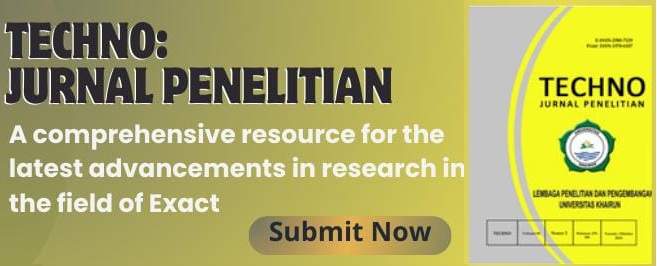Toward Resilience City: Potential Hazards and Scenario for Ternate Island, North Maluku
Abstract
Natural hazards and climate change significantly threaten almost every small island. This is due to the small island's isolation and lack of resources. Ternate Island is a small island that is now afflicted by this issue. Geographically, the island is surrounded by active plates and volcanic paths, making it at risk of serious catastrophes. Population growth and limited land resources also contribute to a high disaster susceptibility. We characterize the features of the small island of Ternate by classifying the types of disasters that threaten it based on a literature database. Earthquakes, volcanic eruptions, floods, extreme weather events, and tsunamis are natural disasters that occur often in Ternate. Additionally, these findings indicate the significant importance of a multi-hazard approach to disaster response. Our examination concludes with some recommendations for establishing the resilience of Ternate City.
Keywords
Full Text:
PDFReferences
Ahmad, S. L., Ahsan, & Fathoni, M. (2018). Factor analysis related to family preparedness facing disaster impact in Ternate city of Maluku Utara province. Jurnal Ilmu Keperawatan, 6(1), 108–123. www.jik.ub.ac.id
Alberti, M. (1996). Measuring urban sustainabilityAlberti, M. (1996). Measuring urban sustainability. Environmental Impact Assessment. Environmental Impact Assessment Review, 16(4–6), 381–424. https://doi.org/10.1016/S0195-9255(96)00083-2
Aldrian, E., & Dwi Susanto, R. (2003). Identification of three dominant rainfall regions within Indonesia and their relationship to sea surface temperature. International Journal of Climatology, 23(12), 1435–1452. https://doi.org/10.1002/joc.950
Allenby, B., & Fink, J. (2005). Toward inherently secure and resilient societies. Science, 309(5737), 1034–1036. https://doi.org/10.1126/science.1111534
Andi, I. (2011). Pemahaman Masyarakat dalam Mengantisipasi Bencana Gempa Bumi (Studi Kasus di Kelurahan Mangga Dua Utara Kecamatan Kota ternate Selatan, Kota Ternate) (Thesis). Universitas Gadjah Mada.
Angkotasan, A. M., Nurjaya, I. W., & Natih, N. M. N. (2012). Analisis Perubahan Garis Pantai di Pantai Barat Daya Pulau Ternate, Provinsi Maluku Utara (Shoreline Change Analysis of the Southwest Coast at Ternate Island, North Molucas Province). Jurnal Teknologi Perikanan Dan Kelautan, 3(2), 11–22. https://doi.org/https://doi.org/10.24319/jtpk.3.11-22
Anwar, S. (2021). Perbandingan Nilai Hazard Kejadian Tsunami di Indonesia Berdasarkan Posisi Garis Khatulistiwa (Katalog Tsunami Indonesia 1802 - 2018). In Jurnal Lingkungan dan Bencana Geologi (Vol. 12, Issue 1, pp. 33–45). Pusat Air Tanah dan Geologi Tata Lingkungan, Badan Geologi. https://doi.org/10.34126/jlbg.v12i1.303
Badan Nasional Penanggulangan Bencana. (2020). Rencana Nasional Penanggulangan Bencana 2020-2024.
Badan Nasional Penanggulangan Bencana (BNPB). (2012). Dokumen Kajian Risiko Bencana Kota Ternate, Provinsi Maluku Utara. In Pemerintah Kota Ternate. Badan Nasional Peanggulangan Bencana.
Badan Nasional Penanggulangan Bencana (BNPB). (2022, May 1). Data Informasi Bencana Indonesia 2022. Dibi.Bnpb.Go.Id. https://dibi.bnpb.go.id/#
Barnett, J. (2011). Dangerous climate change in the Pacific Islands: Food production and food security. Regional Environmental Change, 11(SUPPL. 1), 229–237. https://doi.org/10.1007/s10113-010-0160-2
Birkmann, J. (2006). Measuring Vulnerability to Natural Hazards: Towards Resilien Disaster Resilient Societies (J. Birkmann, Ed.). United Nation University Press.
Bock, Y., Prawirodirdjo, Genrich, J. F., Stevens, C. W., McCaffrey, R., Subarya, C., Puntodewo, S. S. O., & Calais, E. (2003). Crustal motion in Indonesia from Global Positioning System measurements. Journal of Geophysical Research, 108(B8). https://doi.org/10.1029/2001jb000324
BPS. (2022). Kota Ternate dalam Angka 2022 (Ternate Municipality in Figures 2022).
Briguglio, L. (1995). Small Island Developing States and Their Economic Vulnerabilities. In World Development (Vol. 23, Issue 9).
Brilliantina, M., Pratiwi, H., & Susanti, Y. (2021). Analisis Seismisitas pada Data Gempa Bumi di Provinsi Maluku Utara Penerapan Model Epidemic Type Aftershock Sequence (ETAS). Prosiding Pendidikan Matematika Dan Matematika, 4.
Brune, S., Babeyko, A. Y., & Sobolev, S. V. (2009). Are tilt measurements useful in detecting tsunamigenic submarine landslides? Geochemistry, Geophysics, Geosystems, 10(6). https://doi.org/10.1029/2009GC002491
Bruneau, M., Chang, S. E., Eguchi, R. T., Lee, G. C., O’Rourke, T. D., Reinhorn, A. M., Shinozuka, M., Tierney, K., Wallace, W. A., & Von Winterfeldt, D. (2003). A Framework to Quantitatively Assess and Enhance the Seismic Resilience of Communities. Earthquake Spectra, 19(4), 733–752. https://doi.org/10.1193/1.1623497
Carpenter, S., Walker, B., Anderies, J. M., & Abel, N. (2001). From Metaphor to Measurement: Resilience of What to What? Ecosystems, 4(8), 765–781. https://doi.org/10.1007/s10021-001-0045-9
Demets, C., Gordon, R. G., Argus, D. F., & Stein, S. (1994). Effect of Recent Revisions to the Geomagnetic Reversal Time-Scale on Estimates of Current Plate Motions. Geophysical Research Letters, October. https://doi.org/10.1029/94GL02118
Derissen, S., Quaas, M. F., & Baumgärtner, S. (2011). The relationship between resilience and sustainability of ecological-economic systems. Ecological Economics, 70(6), 1121–1128. https://doi.org/10.1016/j.ecolecon.2011.01.003
Dian D, A. (2014). Evaluasi Kinerja Sistem Peringatan Dini Tsunami di Indonesia. INDEPT, 4(1). https://doi.org/https://jurnal.unnur.ac.id/index.php/indept/article/view/133
Djainal, H. (2017). Analisis Reklamasi Pantai Kota Ternate dan Pengaruhnya Terhadap Lingkungan Fisik Kawasan Pesisir. Jurnal Teknologi, 16(2), 2099–2104.
Elake, A. Y., Talahatu, M., & Nanlohy, P. (2018). Korelasi Multivariabel Enso, Monsun Dan Dipolemode Terhadap Variabilitas Curah Hujan di Maluku. Barekeng: Jurnal Ilmu Matematika Dan Terapan, 12(1), 7. https://doi.org/10.30598/vol12iss1pp7-16ar359
Evrita, K., Marfai, M. A., Khakim, N., & Mei, E. T. W. (2014). Tsunami susceptibility mapping in the coastal area of Ternate Island. Proc. SPIE 11372, Sixth International Symposium on LAPAN-IPB Satellite.
Febriyanti, F., Martini, S., Hidajah, A. C., & Dwirahmadi, F. (2021). A Study on Community Economic Resilience in Response to Earthquakes in Jailolo Sub-District, North Maluku. Jurnal Berkala Epidemiologi, 9(2), 105. https://doi.org/10.20473/jbe.v9i22021.105-114
Firmansyah. (2011). Identifikasi tingkat risiko bencana letusan Gunung Api Gamalama di Kota Ternate. Jurnal Lingkungan Dan Bencana Geologi, 2(3), 203–219. https://doi.org/http://dx.doi.org/10.34126/jlbg.v2i3
Gusman, A. R., Nugraha, A. D., & Shiddiqi, H. A. (2017). Hypocenter relocations and tsunami simulation for the 15 November 2014 Northern Molucca Sea earthquake in Indonesia. Jurnal Geofisika, 15(3), 1. https://doi.org/10.36435/jgf.v15i1.29
Hall, R. (2009). Indonesia Geology. In R. Gillespie & D. Clague (Eds.), Encyclopedia of Islands (pp. 454–460). University of California Press. https://www.academia.edu/38049155/Indonesia Geology
Hall, R., Nichols, G., Ballantyne, P., Charlton, T., & Ali~, J. (1991). The character and significance of basement rocks of the southern Molucca Sea region. Journal of Southeast Asian Earth Sciences, 6(4), 249–258.
Hermon, D. (2012). Mitigasi Bencana Hidrometeorolog Banjir, Longsor, Ekologi, Degradasi Lahan, Puting Beliung, Kekeringan. In UNP Press. UNP Press.
Hidayat, A., Marfai, M. A., & Hadmoko, D. S. (2019). Pemetaan Pulau Vulkanik Kecil di Indonesia: Studi Pendahuluan untuk Manajemen Bencana Erupsinya. Jurnal Planoearth, 4(2), 95. https://doi.org/10.31764/jpe.v4i2.1145
Hidayat, A., Marfai, M. A., & Hadmoko, D. S. (2020a). Eruption hazard and challenges of volcanic crisis management on a small Island: A case study on Ternate Island - Indonesia. International Journal of GEOMATE, 18(66), 171–178. https://doi.org/10.21660/2020.66.ICGeo43
Hidayat, A., Marfai, M. A., & Hadmoko, D. S. (2020b). The 2015 eruption of Gamalama volcano (Ternate Island–Indonesia): precursor, crisis management, and community response. GeoJournal. https://doi.org/10.1007/s10708-020-10237-w
Horspool, N., Pranantyo, I., Griffin, J., Latief, H., Natawidjaja, D. H., Kongko, W., Cipta, A., Bustaman, B., Anugrah, S. D., & Thio, H. K. (2014). A probabilistic tsunami hazard assessment for Indonesia. Natural Hazards and Earth System Sciences, 14(11), 3105–3122. https://doi.org/10.5194/nhess-14-3105-2014
Ibrahim, A. H., Husen, T., Hariyatmoko, K., Djae, R. M., & Wance, M. (2021). Implementation of Standard Operational Procedures (SOP) Information Dissemination of BMKG Tsunami Early Warning at the Geophysical Statium of Ternate. Annals of R.S.C.B., 25(2), 2317–2327. https://doi.org/http://annalsofrscb.ro
Ibrahim, & Rosita. (2020). Persepsi Masyarakat Terhadap Pertambangan Galian C di Kota Ternate. Prosiding Seminar Nasional Agribisnis 2020 Fakultas Pertanian Universitas Khairun, November, 149–152.
Ikqra, Tjahjono, B., & Sunarti, E. (2012). Studi Geomorfologi Pulau ternate dan Penilaian Bahaya Longsor. Jurnal Tanah Lingkungan, 14(1), 1–6. https://doi.org/https://doi.org/10.29244/jitl.14.1.1-6
Indotimur.com. (2021). bpbd-catat-375-warga-ternate-dievakuasi-akibat-gelombang-pasang. https://indotimur.com/ternate/
Iturriza, M., Hernantes, J., & Labaka, L. (2019). Coming to action: Operationalizing city resilience. Sustainability (Switzerland), 11(11). https://doi.org/10.3390/su11113054
Kappes, M. S., Gruber, K., Frigerio, S., Bell, R., Keiler, M., & Glade, T. (2012). The MultiRISK platform: The technical concept and application of a regional scale multihazard exposure analysis tool. Geomorphology, 151–152, 139–155. https://doi.org/10.1016/j.geomorph.2012.01.024
Komendantova, N., Mrzyglocki, R., Mignan, A., Khazai, B., Wenzel, F., Patt, A., & Fleming, K. (2014). Multi-hazard and multi-risk decision-support tools as a part of participatory risk governance: Feedback from civil protection stakeholders. International Journal of Disaster Risk Reduction, 8, 50–67. https://doi.org/10.1016/j.ijdrr.2013.12.006
Kosuma, S., Palar, S. W., & Lapian, A. L. Ch. P. (2016). Analisis Struktur Perekonomian Dan Pertumbuhan Ekonomi Di Kota Ternate. Jurnal Berkala Ilmiah Efisiensi, 16(2), 507–516. https://ejournal.unsrat.ac.id/v3/index.php/jbie/article/view/12757/12350
Kurniawan, T., Yuliatmoko, R. S., Sunardi, B., Prayogo, A. S., Muzli, M., & Rohadi, S. (2021). Tsunami Simulation for Disaster Mitigation Based on Earthquake Scenarios in the Molucca Subduction Zone (Case Study of the Molucca Sea Earthquake on July 7, 2019). AIP Conference Proceedings, 2320. https://doi.org/10.1063/5.0037665
Kurnio, H., Naibaho, T., & Purwanto, C. (2019). Review of Submarine Landslides in the Eastern Indonesia Region. Bulletin of the Marine Geology, 34(2), 63–76. https://doi.org/doi:10.32693/bomg.34.2.2019.618.
La Masinu, A., Yustesia, A., & Suwardi. (2018). Sistem Tektonik Dan Implikasinya Terhadap Gempa Bumi Di Pulau Halmahera. Jurnal Pendidikan Geografi, 23(1), 20–29. http://journal2.um.ac.id/index.php/jpg/ISSN:0853-9251
Lessy, M. R., & Abdullah, R. M. (2021). Forecasting of Significant Wave Height and Period at Western Waters of Ternate Island, North Maluku. Techno: Jurnal Penelitian, 10(1). https://doi.org/http://dx.doi.org/10.33387/tjp.v10i1.3026
Lessy, M. R., Wahiddin, N., Bemba, J., Abdullah, R. M., & Mustafa. (2019). Kajian Ancaman Abrasi Pantai di Wilayah Pesisir Kabupaten Halmahera Tengah, Maluku Utara. Pertemuan Ilmiah Tahunan (PIT) HATHI Ke-36, 801–810.
Løvholt, F., Kühn, D., Bungum, H., Harbitz, C. B., & Glimsdal, S. (2012). Historical tsunamis and present tsunami hazard in eastern Indonesia and the southern Philippines. Journal of Geophysical Research: Solid Earth, 117(9), 1–19. https://doi.org/10.1029/2012JB009425
Maclaren, V. W. (1996). Urban sustainability reporting. Journal of the American Planning Association, 62(2), 184–202. https://doi.org/10.1080/01944369608975684
Malalgoda, C., Amaratunga, D., & Haigh, R. (2013). Creating a disaster resilient built environment in urban cities: The role of local governments in Sri Lanka. International Journal of Disaster Resilience in the Built Environment, 4(1), 72–94. https://doi.org/10.1108/17595901311299017
Marasabessy, F. (2016). Hirarki Wilayah Kota Ternate Pasca Pengembangan Kawasan Waterfront City. Jurnal Wilayah Dan Lingkungan, 4(3), 213. https://doi.org/10.14710/jwl.4.3.213-224
Marchese, D., Reynolds, E., Bates, M. E., Morgan, H., Clark, S. S., & Linkov, I. (2018). Resilience and sustainability: Similarities and differences in environmental management applications. Science of the Total Environment, 613–614, 1275–1283. https://doi.org/10.1016/j.scitotenv.2017.09.086
Marfai, M. A., Mutaqin, B. W., Hadmoko, D. S., Wijayanti, H., Lavigne, F., & Faral, A. (2021). The physical characteristics of the small volcanic island of Tidore and Hiri to support disaster management in Maluku. IOP Conference Series: Earth and Environmental Science, 851(1). https://doi.org/10.1088/1755-1315/851/1/012008
Masinu, A. La, Riva, M., & Mane, D. La. (2018). Fenomena Gunung Api Gamalama Terhadap Dampak Aliran Lahar. Jurnal Pendidikan Geografi, 23(2), 113–121. https://doi.org/10.17977/um017v23i22018p113
Mutaqin, B. W., Handayani, W., Satya Candra Rosaji, F., Wahyuningtyas, D., & Aris Marfai, M. (2021). Geomorphological Analysis for the Identification of Small Volcanic islands in North Maluku, Indonesia. Jurnal Geografi, 13(2), 184–194. https://doi.org/https://doi.org/10.24114/jg.v13i2.21526
Mutaqin, B. W., Marfai, M. A., Hadmoko, D. S., Lavigne, F., Faral, A., Wijayanti, H., & Riasasi, W. (2021). Geomorphology of the small island of Tidore and Hiri (North Maluku, Indonesia). E3S Web of Conferences, 325, 03012. https://doi.org/10.1051/e3sconf/202132503012
Nagu, N., Lessy, M. R., & Achmad, R. (2018). Adaptation Strategy of Climate Change Impact on Water Resources in Small Island Coastal Areas: Case Study on Ternate Island-North Maluku. KnE Social Sciences, 3(5), 424. https://doi.org/10.18502/kss.v3i5.2347
Nugroho, S. H., & Sadisun, I. A. (2015). Tinjauan Tentang Mitigasi Bahaya Tsunami di Pesisir Pantai dan Pulau-Pulau Kecil. Oseana, 15(1), 14–52.
Pasau, G., & Tanauma, D. A. (2011). Pemodelan sumber gempa di wilayah Sulawesi Utara sebagai upaya mitigasi bencana gempa bumi. Jurnal Ilmiah Sains, 11(2), 202–209. https://doi.org/https://ejournal.unsrat.ac.id/v3/index.php/JIS/issue/view/122
Patel, R., & Nosal, L. (2016). Defining the Resilient City. In United Nations University Centre for Policy Research (6; 6, Issue December). https://cpr.unu.edu/defining-the-resilient-city.html
Pradiptasari, A. G., Waani, J. O., & Mononimbar, W. (2015). Sistem Penanggulangan Bencana Gunung Api Gamalama di Permukiman Kampung Tubo Kota Ternate. Spasial: Perencanaan Wilayah Dan Kota, 2(3), 33–42. https://doi.org/https://doi.org/10.35793/sp.v2i3.9828
Priatmodjo, D. (2011). Penataan Kota Bermuatan Antidipasi Bencana. Nalars, 10(2). https://doi.org/https://doi.org/10.24853/nalars.10.2.%25p
Rockefeller. (2015). City Resilience Index. www.arup.com/cri
Sabrina, V., Adib Azka, M., Aditya Sugianto, P., & S. (2021). Kajian Meteorologis saat kejadian bencana Hidrometeorologis di Maluku Utara (Studi kasus: 15-16 Januari 2021. Jurnal Widya Climago, 3(2), 53. https://ejournal-pusdiklat.bmkg.go.id/index.php/climago/article/view/35/30
Said, M. (2019). Reklamasi Dan Dampaknya Terhadap Wilayah Pesisir Pantai Toboko Kota Ternate. Dintek, 12(2), 83–91.
Said, R. M. (2019). Kota Ternate pada masa Pemerintahan Belanda. Jurnal Penelitian Humano, 10(2), 426–436. http://ejournal.unkhair.ac.id/index.php/humano
Saifuddin, A., & Pertiwi, E. I. (2021). Pemetaan Zona Risiko Gempabumi berdasarkan Peak Ground Acceleration Terhadap Energi dan Sumberdaya Mineral di Provinsi Maluku Utara. Seminar Nasional Geomatika, 171. https://doi.org/10.24895/sng.2020.0-0.1132
Saputra, H., Wahid Hasyim, A., & Rachmansyah, A. (2015). Penataan Kawasan Bencana Lahar Dingin Di Kecamatan Ternate Tengah Dan Ternate Utara. Indonesian Green Technology Journal, 4(1), 1–10. https://doi.org/https://igtj.ub.ac.id/index.php/igtj/article/view/130
Sarihi, Y. R., Tilaar, S., & Rengkung, M. M. (2020). Analisis Penggunaan lahan di Pulau Ternate. Jurnal SPASIAL, 7(3). https://ejournal.unsrat.ac.id/v3/index.php/spasial/article/view/30840
Sofyan, A., Dudibiyakto, & Sahubawa, L. (2010). Kajian Erosi Marine Sebagai Penyebab Degradasi Kepesisiran Kota Ternate. Jurnal Manusia Dan Lingkungan, 17(2), 89–97. https://doi.org/10.22146/jml.18707
Sriyanto, S. P. D., Nurfitriani, N., Zulkifli, M., & Wibowo, S. N. E. (2019). Permodelan Inundasi dan Waktu Tiba Tsunami di Kota Bitung, Sulawesi Utara Berdasarkan Skenario Gempabumi Laut Maluku. Geomatika, 25(1), 47–54. https://doi.org/10.24895/jig.2019.25-1.959
Sulaeman, C., & Cipta, A. (2012). Model intensitas gempa bumi di Maluku Utara Earthquake Intensity Model in North Maluku. Jurnal Lingkungan Dan Bencana Geologi, 3(2), 79–88. https://doi.org/http://dx.doi.org/10.34126/jlbg.v3i2.38
Sumtaki, M. I., Pasaua, G., & Seni, H. J. T. (2017). Simulasi Penjalaran Gelombang Tsunami di Sofifi– Tidore Kepulauan Maluku Utara sebagai Upaya Mitigasi Bencana. Jurnal MIPA UNSRAT Online, 6(1), 83–87. https://doi.org/https://ejournal.unsrat.ac.id/v3/index.php/jmuo/issue/view/1592
Supartoyo. (2015). Gempa Bumi Laut Maluku Tanggal 15 November 2014. Jurnal Lingkungan Dan Bencana Geologi, 6(1), 45–58. https://doi.org/http://dx.doi.org/10.34126/jlbg.v6i1.75
Surahman. (2007). Analisis Tingkat Perubahan Penggunaan Lahan Wilayah Pesisir Kota Ternate (Thesis) [Universitas Hasanuddin]. http://repository.unhas.ac.id/id/eprint/6970
Syiko, S. F., Ayu R, T., & Yudono, A. (2013). Evacuation Route Planning in Mount Gamalama, Ternate Island-Indonesia. Procedia Environmental Sciences, 17, 344–353. https://doi.org/10.1016/j.proenv.2013.02.047
Tuhuteru, E. (2020). IIdentifikasi Rumah Sederhana Tahan Gempa di Kota ternate (studi kasus di Kelurahan Tafure). Clayperon: Jurnal Ilmiah Teknik Sipil, 1(2), 52–65. https://doi.org/https://doi.org/10.33387/clapeyron.v1i2
Umanailo, H. A., Franklin, P. J. C., & Waani, J. O. (2017). Perkembangan Pusat Kota Ternate (Studi Kasus: Kecamatan Ternate Tengah). Spasial, 4(3), 222–233. https://doi.org/https://doi.org/10.35793/sp.v4i3.18268
UNISDR, U. N. I. S. for D. R. (2015). The Economic and Human Impact of Disasters in the Last 10 Years.
United Nations. (2007). Indicators of Sustainable Development: Guidelines and Methodologies. In New York: Vol. Third edition (3rd ed., Issue October). United Nations publication.
Vrita, A. T., Salam, R., & Farida, A. (2021). Prediksi Kebutuhan Area Permukiman di Kota Ternate. Space, 8, 111–122. https://doi.org/https://doi.org/10.24843/JRS.2021.v08.i02.p03
Wagner, I., & Breil, P. (2013). The role of ecohydrology in creating more resilient cities. Ecohydrology and Hydrobiology, 13(2), 113–134. https://doi.org/10.1016/j.ecohyd.2013.06.002
Zulkifli, M., Rudyanto, A., & Sakti, A. P. (2017). The view of seismic hazard in the Halmahera region. AIP Conference Proceedings, 1857. https://doi.org/10.1063/1.4987082
DOI: https://doi.org/10.33387/tjp.v13i1.7329
Refbacks
- There are currently no refbacks.
Copyright (c) 2024 Mohammad Ridwan Lessy, Nani Nagu

This work is licensed under a Creative Commons Attribution-NonCommercial 4.0 International License.
-------------------------------------------------------------------------------------------------------------------------------------------------------------------
-------------------------------------------------------------------------------------------------------------------------------------------------------------------
TECHNO: Jurnal Penelitian
Published by: LPPM Universitas Khairun
Addres : Jalan Yusuf Abdurrahman Kampus II Unkhair, Kelurahan Gambesi, 97722 Kecamatan Kota Ternate Selatan, Provinsi Maluku Utara, Email: techno@unkhair.ac.id | URL: http://ejournal.unkhair.ac.id/index.php/Techno
Techno Jurnal Penelitian is licensed under a Creative Commons Attribution-NonCommercial 4.0 International License.



























